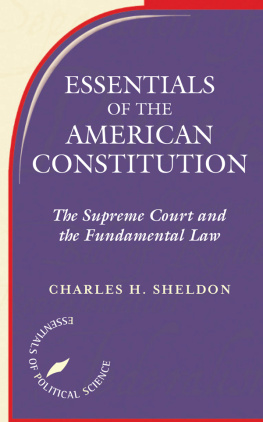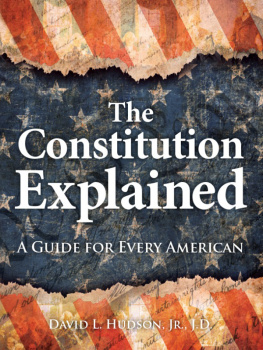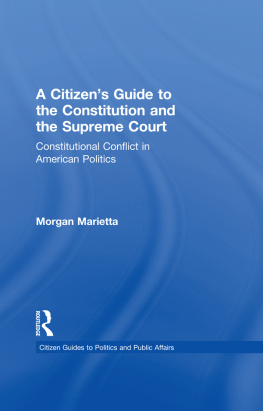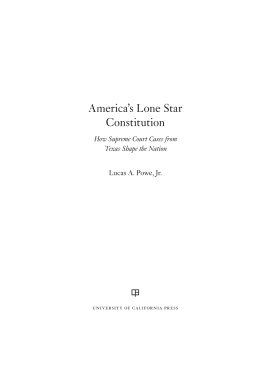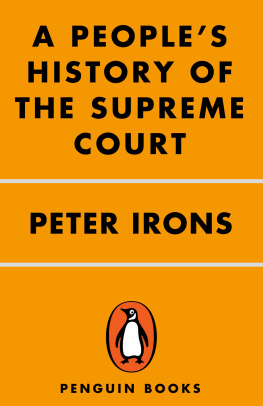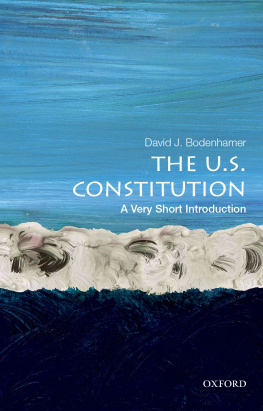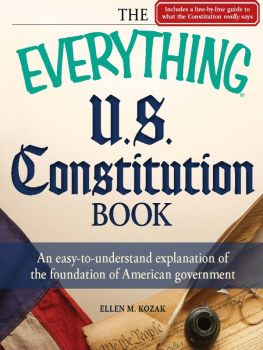Essentials of the American Constitution
Essentials of Political Science
James A. Thurber, American University, Editor
The Essentials of Political Science Series will present faculty and students with concise texts designed as primers for a given college course. Many will be 200 pages or shorter. Each will cover core concepts central to mastering the topic under study. Drawing on their teaching as well as research experiences, the authors present narrative and analytical treatments designed to fit well within the confines of a crowded course syllabus.
Essentials of the Constitution:
The Supreme Court and the Fundamental Law,
by Charles O. Sheldon as edited by Stephen L. Wasby
Essentials of Political Research,
Alan D. Monroe
Essentials of American Government,
David McKay
Essentials of Political Science
First published 2002 by Westview Press
Published 2018 by Routledge
711 Third Avenue, New York, NY 10017, USA
2 Park Square, Milton Park, Abingdon, Oxon OX14 4RN
Routledge is an imprint of the Taylor & Francis Group, an informa business
Copyright 2002 by Taylor & Francis
All rights reserved. No part of this book may be reprinted or reproduced or utilised in any form or by any electronic, mechanical, or other means, now known or hereafter invented, including photocopying and recording, or in any information storage or retrieval system, without permission in writing from the publishers.
Notice:
Product or corporate names may be trademarks or registered trademarks, and are used only for identification and explanation without intent to infringe.
Library of Congress Cataloging-in-Publication Data
Sheldon, Charles H., 1929-2000
The essentials of the constitution : the Supreme Court and the
fundamental law / Charles H. Sheldon as edited by Stephen L. Wasby.
p. cm. (Essentials of political science)
Includes bibliographical references and index.
ISBN 0-8133-6854-5 (cloth); 0-8133-6855-3 (paper)
1. Constitutional lawUnited States. 2. Separation of powers
United States. 3. Judicial reviewUnited States. 4. United States.
Supreme Court. I. Wasby, Stephen L., 1937-. II. Title. III. Series.
KF4550 .S53 2001
342.73'02dc21
2001017952
ISBN 13: 978-0-8133-6855-9 (pbk)
Contents
by Stephen L. Wasby
After teaching the course Introduction to the American Constitution for over twenty-five years, I have found that the popular approaches political scientists take in teaching this course are inadequate, if not incomplete. First, the historical-political approach explains constitutional cases and doctrine in terms of the politics surrounding the court and the American political system. The tendency is to fragment constitutional evolution into jump-starts, such as the Federalist-Jeffersonian struggle ( Marbury ), slavery and civil war ( Dred Scott ), or economic revolution ( Lochner and West Coast Hotel ). Students tend to come away from such courses as they would from an English literature course based on a text of short stories: interesting, but how does it all fit together?
Another common approach is to borrow the law school case method and attempt to understand constitutional doctrine by teaching students how to think like a lawyer focusing on precedent. Certainly this method works for many, but again, it is a piecemeal approach. Students learn about the First Amendment free speech doctrines or the development of the commerce clause, but rarely do they pull all the doctrines together and say, Here is the American Constitution.
Recently, texts have appeared that focus on the sources of interpretation available to the Supreme Court justices. Opinions are analyzed in terms of the intent of the framers (originalist or intentionalist) or within the wording of the document (contextualist) and the like. From this perspective, constitutional doctrine is not as important as how the justices justified that doctrine. Students thus learn about the reasoning of the justices but little about the fundamentals of the Constitution.
Of course, there are many variations of these approaches, serving different purposes, but to my knowledge, no serious text has successfully integrated constitutional principles into a comprehensible whole. This book is an attempt to do that. It has been tested over the years in the classroom, in many undergraduate classes. With this introduction to constitutional principles, students should be prepared to analyze in detail constitutional cases and doctrine in more advanced courses on constitutional law.
The book describes five fundamental constitutional components: the compact, separation of powers, federalism, representation, and the Bill of Rights. Each component is understood in terms of a location along a dynamic continuum that has been defined and extended by the Supreme Court over the years. After variations of each component are explained, they are integrated with other components. The important concept that the reader is to take away is that these fundamental components of the basic law work together in resolving constitutional issues. One component reinforces, explains, or extends another to bring about the decision. Herein lies the value of this particular approach, which works well within the vocabulary of any observer of the Constitution. Students should be able to see how the American Constitution is complete, with its fundamental principles working together.
Charles Sheldon
Pullman, Washington
* This Preface has been constructed from the authors own words, taken from a letter to his editor at Westview Press, Leo A.W. Wiegman, with only minor changes in wording.
The Constitution, as Professor Sheldon writes, is both instrument and symbol. As instrument, it empowers the branches of government while also constraining them. As symbol, invoked for and against many policy proposals, it seems bigger than life and certainly more than a piece of parchment, and as such it helps serve to bring us together as one nation.
The Constitution is also both simple and complex. Some of its provisions are simple, clear, and specific, while others are ambiguous and open-ended. Even when a constitutional provision seems at first reading to be clear, such clarity may be deceptive. For example, Justice Hugo Black, who always carried a copy of the Constitution in his pocket, regularly expounded that the First Amendments language, Congress shall make no law abridging freedom of speech and press, meant just that: No law abridging means no law abridging! Yet, indicating that many others understood that apparent clarity quite differently, that position has never commanded a majority of the Supreme Court.
The Constitution is complex because the individual pieces of the document may each appear simple while concealing complexity, and, put together, they make for a complex whole, a result of the brilliance of the Founders and the compromises necessary to achieve its ratification. In addition, long-standing practice by Congress and the president and the Supreme Courts rulings have also become embedded in the living Constitution. Such rulings often elaborate on existing provisions, but at other times they add what was not in the text but was at best assumed or inferred. The best example, of course, is judicial reviewthe power of the courts to declare acts of the legislative and executive branches unconstitutionalwhich Chief Justice John Marshall declared in Marbury v. Madison , on which Professor Sheldon draws.

